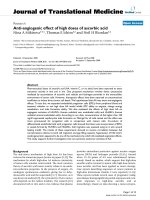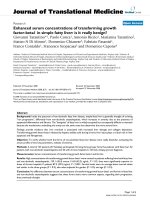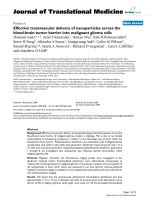Báo cáo hóa học: " Catalytic ozone oxidation of benzene at low temperature over MnOx/Al-SBA-16 catalyst" pdf
Bạn đang xem bản rút gọn của tài liệu. Xem và tải ngay bản đầy đủ của tài liệu tại đây (296.22 KB, 5 trang )
NANO EXPRESS Open Access
Catalytic ozone oxidation of benzene at low
temperature over MnOx/Al-SBA-16 catalyst
Jong Hwa Park
1
, Ji Man Kim
2
, Mingshi Jin
2
, Jong-Ki Jeon
3
, Seung-Soo Kim
4
, Sung Hoon Park
5
, Sang Chai Kim
6
and Young-Kwon Park
1,7*
Abstract
The low-temperature catalytic ozone oxidation of benzene was investigated. In this study, Al-SBA-16 (Si/Al = 20)
that has a three-dimensional cubic Im3m structure and a high specific surface area was used for catalytic ozone
oxidation for the first time. Two different Mn precursors, i.e., Mn acetate and Mn nitrate, were used to synthesize
Mn-impregnated Al-SBA-16 catalysts. The characteristics of these two catalysts were investigated by instrumental
analyses using the Brunauer-Emmett-Teller method, X-ray diffraction, X-ray photoelectron spectroscopy, and
temperature-programmed reduction. A higher catalytic activity was exhibited when Mn acetate was used as the
Mn precursor, which is attributed to high Mn dispersion and a high degree of reduction of Mn oxides formed by
Mn acetate than those formed by Mn nitrate.
Keywords: Al-SBA-16, Mn precursors, benzene, ozone, catalytic oxidation
Introduction
Hazardous air pollutants [HAPs] are airborne species
that are known to or are anticipated to cause adverse
effects on human health and environment. HAPs are
characteri zed by their toxicity, carcinogenicity, bio accu-
mulation, persistence, and dispersion. Most HAPs, how-
ever, are not regulated/managed, producing secondary
pollutants and odor [1]. Benzene, a representative HAP,
is a well-known carcinogen. Long-term exposure to ben-
zene can cause blood dyscrasias such as a decrease in
erythrocytes, aplastic anemia, and leukemia [2]. There-
fore, in recent years, considerable attention has been
paid to the removal of benzene and other HAPs.
Ozone has been widely used for pollution treatment in
the semiconductor industry, water treatment, and air
cleaning [3-5]. In particular, catalytic ozone oxidation
has high pollutant-removal efficiency and low energy
consumption [6]. In the catalytic ozone oxidation pro-
cess, ozone i s decomposed into activated oxygen species
that can oxidize organic compounds. Recently,
researches on the catalytic ozone oxidation of volatile
organic compounds [VOCs] including HAPs have been
performed [7-9]. The HAP r emoval process involving
ozone addition is economically advantageous because it
can be performed at a temperature much lower than
that required for conventional HAP removal processes.
Thus far, Al
2
O
3
,SiO
2
, and zeolite catalysts impregnated
with metal have usually been used for catalytic ozone
oxidation. In particular, su pports with a large specific
surface area have good dispersion of metal oxides within
the supports, leading to high reaction activity [4,9].
Recently, mesoporous materials such as MCM-41 and
SBA-15 have been widely used as supports for various
reactions because of their uniform pores and large spe-
cific surface areas. In particular, SBA-16 is expected to
exhibit high activity during the catalytic ozone oxidation
of benzene because of its super-large cage, large surface
area, and high thermal stability. The three-dimensional
channel connectivity of SBA-16 makes it even more
favorable for mass-transfer kinetics than the oth er hexa-
gonal mesoporous materials having unidirectional pore
structures. To the best of our knowledge, SBA-16 has
never been used for the catalytic ozone oxidation of
benzene. MnO
x
is a metal oxide that exhibits high activ-
ity during the decomposition of VOCs at a low tempera-
ture [10]. Therefore, in this study, Al-SBA-16 was
impregnated with Mn by using two different Mn precur-
sors, i.e., Mn(CH
3
COO)
2
(Mn acetate) and Mn(NO
3
)
2
* Correspondence:
1
Graduate School of Energy and Environmental System Engineering,
University of Seoul, Seoul 130-743, South Korea
Full list of author information is available at the end of the article
Park et al. Nanoscale Research Letters 2012, 7:14
/>© 2012 Park et al; licensee Springer. This is an Open Access article distributed under the terms of the Creative Commons Attribution
License ( which permits unrestricted use, distribution, and reproduction in any med ium,
provided the original work is properly cited.
(Mn nitrate), to investigate the effect of Mn precursors
on the catalytic ozone oxidation of benzene.
Experimental details
Synthesis of MnO
x
/Al-SBA-16 catalysts
The detailed procedure for the synthesis of mesoporous
silica SBA-16 with cubic Im3m structure is described in
the literature [11]. A poly(alkylene oxide)-type triblock
copolymer, i.e., F127 (EO
106
PO
70
EO
106
, MW = 12,600,
Sigma, St. Louis, MO, USA), was dissolved in an aqueous
HCl solution, and tetraethyl orthosilicate [TEOS] (98%)
was added at 35°C. The solution was stirred for 15 min
by a magnetic stirrer at the same temperature. The molar
composition of the m ixture was F127:TEOS:HCl:H
2
O=
0.0040:1.0:4.0:130. This mixture was put in an oven for
24 h at the same temperature. The mixture was then put
in an oven at an elevated temperature of 100°C for 24 h.
After this hydro thermal ag ing, the s olid pro duct f ormed
was recovered by filtration and was dried at 100°C with-
out washing. The dried sample was washe d with ethanol,
dried in an oven at 100°C, and calcined at 550°C. Al
incorpor ation in the sample was performed with an etha-
nolic solution of AlCl
3
(Si/Al = 20). After completely eva-
porating the solvent (ethanol) in a rotary evaporator, the
sample was calcined in air at 550°C. The Al-incorporated
sample is hereafter referred to as Al-SBA-16.
The amount of Mn impregnated using Mn(NO
3
)
2
(98%, Aldrich, St. Louis, MO, USA) and Mn(CH
3
COO)
2
(> 99%, Aldrich, St. Louis, MO, USA) as the Mn precur-
sors was 15 wt.%. The Mn-impregnated material was
calcined at 550°C. Al-SBA-16 catalysts synthesized using
Mn nitrate and Mn acetate as the Mn precursors are
hereafter referred to as Al-SBA-16-MN15% and Al-
SBA-16-MA15%, respectively.
Characterization of MnO
x
/Al-SBA-16
X-ray diffraction [XRD] patterns of the catalyst were
obtained using an X-ray diffractometer (D/MAX-III,
Rigaku, Akishima, Japan) with Cu-Ka radiation. The N
2
adsorption-desorption isotherms and the Brunauer-
Emmett-Teller [BET] surface area of the catalyst were
obtained using an ASAP-2010 apparatus (Micromeritics,
Norcross, GA, USA). Temperature-programmed reduc-
tion [TPR] analysis was performed using a ChemBET
3000 (Quantachrome, Boy nton Beach, FL, USA) setup.
X-ray photoelectron spectroscopy [XPS] was performed
using an AXIS Nova spectrometer (Kratos Inc., NY,
USA). A monochromatic Al Ka (1,486.6 eV) of X-ray
source and 40 eV of analyzer pass energy were used
under ultra-high vacuum conditions (5.2 × 10
-9
Torr).
Benzene oxidation with ozone
Catalytic reaction experiments were performed in a
fixed-bed flow reactor. Ozone was p roduced from O
2
using a silent-discharge ozone generator. Before each
experiment, the sample was heated at 450°C in a Pyrex
glass reactor under an O
2
flow. The c atalyst was then
cooled and maintained at 80°C. In each experiment, 0.05
g of the catalyst was used. The ozone flow rate and ben-
zeneinletconcentrationweresetat120mL/minand
100 ppm, respectively. The product gas sample was
passed through a GC/FID (6000 Series, Young Lin, Any-
ang, South Korea) with an HP- 5 column (Agilent Tech-
nologies Inc., Santa Clara, CA, USA) to analyze the
benzene conversion, an indoor gas analyzer (ISR-401,
WOORI Industrial System Co., Ltd., Chungcheongbu k-
do, South Korea) used for the CO and CO
2
products,
and an ozone analyzer (LAB-S, Ozonetech, Daejeon,
South Korea) for the ozone conversion. In this study,
the gas-phase reaction of benzene with ozone was
shown to be negligible.
Results and discussion
Characterization of Al-SBA-16
Table 1 lists the textural properties of Al-SBA-16 cata-
lysts i mpregnated with Mn nitrate and Mn acetate. Al-
SBA-16-MN15% had a greater BET surface area than
Al-SBA-16-MA15%.
The XRD pattern of the synthesized SBA-16 is shown
in Figure 1, which could be identified as that of a cubic
SBA-16 with sharp (110) and small (200) reflections.
This result indicates that the cubic mesostructure was
not destructed by the incorporation of alumina on the
silica framework. It is shown in Figure 1 that the Mn/
Al-SBA-16 prepared by using Mn nitrate (Al-SBA-16-
MN15%) exhibited high-angle peaks repre senting
Mn
2
O
3
particles, while the Mn/Al-SBA-16 prepared by
using Mn acetate (Al-SBA-16-MA15%) exhibited no
Mn-particle pea k. This result indicates that Mn was dis-
persed uniformly within Al-SBA-16-MA15%, whereas it
was poorly dispersed in Al-SBA-16-MN15%, and Mn
oxides existed as large-sized particles.
Figure 2 shows a comparison between the Mn 2p XPS
spectra of Al-SBA-16-MA15% and Al -SBA-16 -MN15%.
The peak for Al-SBA-16-MN15% was divided into three
peaks located at 641.2, 642.3, and 644.1 eV obtained by
peak deconvolution, representing Mn
2
O
3
(641.2 ± 0 .2
eV), MnO
2
(642.2 ± 0.4 eV), and Mn nitrate (644.2 ±
0.4 eV), respec tively [12]. On the other hand, the peak
for Al-SBA-16-MA15% was divided into two peaks
located at 641.2 and 642.3 eV, implying the dominance
Table 1 Textural properties of the catalysts
S
BET
(m
2
/g)
Pore size
(nm)
Al-SBA-16 MA15% 359 4.94
Al-SBA-16 MN15% 489 4.60
Park et al. Nanoscale Research Letters 2012, 7:14
/>Page 2 of 5
of Mn
2
O
3
within Al-SBA-16-MA 15%. The XRD and
XPS results suggested that well-dispersed Mn oxides
were formed by Mn acetate, while several different types
of poorly dispersed Mn oxides were formed by Mn
nitrate. On the basis of these results, it was expected
that Al-SBA-16-MA15% would show a higher activity
for the catalytic ozone oxidation of benzene than Al-
SBA-16-MN15%.
As shown by the TPR results (Figure 3), Al-SBA-16-
MA15% has higher reduction ability than Al-SBA-16-
MN15%. This implies that Al-SBA-16-MA15% has
higher lattice oxygen mobility, leading to higher activity
for the oxidation reaction. In addition, as mentioned
above, the order of catalytic activity for the VOC
oxidationofMnoxidesisMn
3
O
4
>Mn
2
O
3
>MnO
2
[13]. In this study, it was shown that highly active
Mn
2
O
3
was dispersed well in Al-SBA-16-MA15%, while
Al-SBA-16-MN15% contained large-sized Mn
2
O
3
parti-
cles, resulting in low activity. Moreover, Al-SBA-16-
MN15% contained MnO
2
and Mn nitrate with low
activity, which is supposed to be another reason for the
low activity of Al-SBA-16-MN15%.
Benzene oxidation with ozone
Figure 4 shows a comparison between the conversions
of benzene and ozone obtained using two Mn-impreg-
nated Al-SBA-16 catalysts. For 80 min, Al-SBA-16-
MA15% showed benzene and ozone conversions about
Figure 1 The powder XRD patterns of Al-SBA-16 with various Mn precursors.
!"
!"
Figure 2 XPS spectra of Al-SBA-16 with various Mn precursors.
Temperature
(
Ԩ
Ԩ )
0 100 200 300 400 500 600 70
0
Intensity (a.u.)
Al-SBA-16 MA15%
Al-SBA-16 MN15%
Figure 3 TPR of Al-SBA-16 with various Mn precursors.
Park et al. Nanoscale Research Letters 2012, 7:14
/>Page 3 of 5
5% higher than those shown by A l-SBA-16-MN15%
despite having a low surface area. The conversions
reduced with an increasing reaction time for both Al-
SBA-16-MA15% and Al-SBA-16-MN15%; however, the
extent of reduction was larger for Al-SBA-16-MN15%.
Figure 5 shows the benzene conversions and yields of
CO
x
(CO
2
+ CO) obtained for 80 min of reaction time
using two catalysts. Both the benzene conversion and
CO
x
yield were about 85% for Al-SBA-16-MA15%,
whereas for Al-SBA-16-MN15%, the CO
x
yield (74%)
was significantly lower than the benzene conversion
(81%). As shown by the TPR results, Al-SBA-16-
MA15% has a higher degree of reduction than Al-SBA-
16-MN15%, which may lead to higher lattice oxygen
mobility and higher oxidation activity. It has been
reported that the order of catalytic activity of Mn oxides
for the oxidation of VOCs is Mn
3
O
4
>Mn
2
O
3
>MnO
2
[13]. In this study too, Al-SBA-16-MA15% containing
well-dispersed, more-active Mn
2
O
3
showed a higher
activity for benze ne oxidation, whereas Al-SBA-16-
MN15% containing large-sized Mn-oxide particles,
including less-active MnO
2
and Mn nitrate together
with Mn
2
O
3
, showed a lower activity.
Figur e 6 shows the CO
x
yield and benzene conversion
obtained by u sing Al-SBA-16-MA15% for 80 min with
different ozone consumptions. It is shown that both the
benzene conversion and CO
x
yield increased with ozone
consumption. When ozone was not added, virtually, no
reaction occurred ( data not shown). Ozone is decom-
posed into oxyge n species as a result of interactions
with Mn oxide, forming catalytic active sites by the fol-
lowing mechanisms [14]:
O
3
→ O
2
+O
∗
(1)
O
∗
+O
3
→ O
2
+O
∗
2
(2)
O
∗
2
→ O
2
+ ∗
(3)
where * represents the catalytic active site. The oxygen
species formed during the decomposition of ozone oxi-
dize benzene, producing oxygen-containing by -products.
These by-products are further oxidized to CO
x
. The fact
that a g as-phase reaction between ozone and benzene
did not occur indicates that ozone itself does not func-
tion as the oxidizer. Rather, ozone is decomposed into
oxygen species by the above-shown mechanisms, and
these oxygen speci es oxidize benzene. As shown in Fig-
ure 6, the consumption of ozone had a good correlation
with the conversion of benzene: a higher benzene con-
version was obtained at a higher consumption of ozone.
Conclusions
Two different Mn precursors were used to synthesize
mesoporous catalysts for the catalytic ozone oxidation
of benzene by impregnating Al-SBA-16 with Mn. The
Time
(
min
)
0 20406080
Benzene
C
onversion
(%)
0
20
40
60
80
100
O
3
Conversion (%)
0
20
40
60
80
100
Al-SBA-16 MA15% Benzene Conversion
Al-SBA-16 MA15% O
3
Converson
Al-SBA-16 MN15% Benzene Conversion
Al-SBA-16 MN15% O
3
Converson
Figure 4 Benzene and ozone conversions over Al-SBA-1 6 with
various Mn precursors at 80°C.
Al-SBA-16 MA15
%
Al-SBA-16 MN15
%
Benzene Conversion (%)
0
20
40
60
80
100
CO
x
Yield (Carbon wt%)
0
20
40
60
80
100
Benzene Conversion
CO
x
Yield
Figure 5 Effect of Mn precursors on benzene conversion and
CO
x
yield over Al-SBA-16. Time on stream, 80 min; temperature,
80°C.
O
3
Consumption
200 400 600 800
CO
x
Yield (Carbon wt%)
0
20
40
60
80
100
Benzene Conversion (%)
0
20
40
60
80
100
CO
x
Yield
Benzene Conversion
Figure 6 Effect of ozone consumption on benzene conversion
and CO
x
yield over Al-SBA-16 with Mn acetate. Time on stream,
80 min; temperature, 80°C.
Park et al. Nanoscale Research Letters 2012, 7:14
/>Page 4 of 5
catalytic activity of Al-SBA-16-MA15% was higher than
that of Al-SBA-16-MN15%. It was shown that the type
of precurso rs used for Mn impregnation influenced the
dispersion, oxidation state, and oxygen mobility of the
impregnated Mn. XRD and TPR analyses showed that
Al-SBA-16-MA15% had better Mn dispersion and a
higher degree of reduction than Al-SBA-16-MN15%.
XPS analysis showed that highly dispersed Mn oxides
could form main active sites for Al-SBA-16-MA15%.
These catalytic properties appear to have induced the
high catalytic activity of Al-SBA-16-MA15%.
Abbreviations
XPS: X-ray photoelectron spectroscopy; XRD: X-ray diffraction.
Author details
1
Graduate School of Energy and Environmental System Engineering,
University of Seoul, Seoul 130-743, South Korea
2
Department of Chemistry,
BK21 School of Chemical Materials Science and Department of Energy
Science, Sungkyunkwan University, Suwon 440-746, South Korea
3
Department of Chemical Engineering, Kongju National University, Cheonan
330-717, South Korea
4
Department of Chemical Engineering, Kangwon
National University, Samcheok 245-711, South Korea
5
Department of
Environmental Engineering, Sunchon National University, Suncheon 540-742,
South Korea
6
Department of Environmental Education, Mokpo National
University, Muan 534-729, South Korea
7
School of Environmental
Engineering, University of Seoul, Seoul 130-743, South Korea
Authors’ contributions
JHP, JMK, MJ, JKJ, SSK, SHP, and SCK participated in some of the studies and
in drafting the manuscript. YKP conceived the study and participated in all
experiments of this study. Also, YKP prepared and approved the final
manuscript. All authors read and approved the final manuscript.
Competing interests
The authors declare that they have no competing interests.
Received: 28 September 2011 Accepted: 5 January 2012
Published: 5 January 2012
References
1. Raun LH, Marks EM, Ensor KB: Detecting improvement in ambient air
toxics: an application to ambient benzene measurements in Houston,
Texas. Atmos Environ 2009, 43:3259-3266.
2. Nakayama A, Koyoshi S, Morisawa S, Yagi T: Comparison of the mutations
induced by p-benzoquinone, a benzene metabolite, in human and
mouse cells. Mutat Res 2000, 27:147-153.
3. De Smedt F, De Gendt S, Heyns MM, Vinckier C: The application of ozone
in semiconductor cleaning processes: the solubility issue. J Electrochem
Soc 2001, 148:G487-G493.
4. Einaga H, Futamura S: Catalytic oxidation of benzene with ozone over
Mn ion-exchanged zeolites. Catal Commun 2007, 8:557-560.
5. Sahledemessie E, Devulapelli V: Vapor phase oxidation of dimethyl sulfide
with ozone over V
2
O
5
/TiO
2
catalyst. Appl Catal B Environ 2008, 84:408-419.
6. Atkinson R: Kinetics and mechanisms of the gas-phase reactions of
ozone with organic compounds under atmospheric conditions. Chem
Rev 1984, 84:437-470.
7. Naydenov A, Stoyanova R, Mehandjiev D: Ozone decomposition and CO
oxidation on CeO
2
. J Mol Catal A Chem 1995, 98:9-14.
8. Gervasini A, Vezzoli GC, Ragaini V: VOC removal by synergic effect of
combustion catalyst and ozone. Catal Today 1996, 29:449-455.
9. Einaga H, Futamura S: Catalytic oxidation of benzene with ozone over
alumina-supported manganese oxides. J Catal 2004, 227:304-312.
10. Peña DA, Uphade BS, Smirniotis PG: TiO
2
-supported metal oxide catalysts
for low-temperature selective catalytic reduction of NO with NH
3
I.
Evaluation and characterization of first row transition metals. J Catal
2004, 221:421-431.
11. Kim TW, Ryoo R, Kruk M, Gierszal KP, Jaroniec M, Kamiya S, Terasaki O:
Tailoring the pore structure of SBA-16 silica molecular sieve through the
use of copolymer blends and control of synthesis temperature and time.
J Phys Chem B 2004, 108:11480-11489.
12. Kapteijn F, Van Langeveld AD, Moulijn JA, Andreini A, Vuurman MA,
Turek AM, Jehng JM, Wachs IE: Alumina-supported manganese oxide
catalysts. I. characterization: effect of precursor and loading. J Catal 1994,
150:94-104.
13. Kim SC, Shim WG: Catalytic combustion of VOCs over a series of
manganese oxide catalysts. Appl Catal B Environ 2010, 98:180-185.
14. Radhakrishnan R, Oyama ST, Chen JGG, Asakura K: Electron transfer effects
in ozone decomposition on supported manganese oxide. J Phys Chem B
2001, 105:4245-4253.
doi:10.1186/1556-276X-7-14
Cite this article as: Park et al.: Catalytic ozone oxidation of benzene at
low temperature over MnOx/Al-SBA-16 catalyst. Nanoscale Research
Letters 2012 7:14.
Submit your manuscript to a
journal and benefi t from:
7 Convenient online submission
7 Rigorous peer review
7 Immediate publication on acceptance
7 Open access: articles freely available online
7 High visibility within the fi eld
7 Retaining the copyright to your article
Submit your next manuscript at 7 springeropen.com
Park et al. Nanoscale Research Letters 2012, 7:14
/>Page 5 of 5









